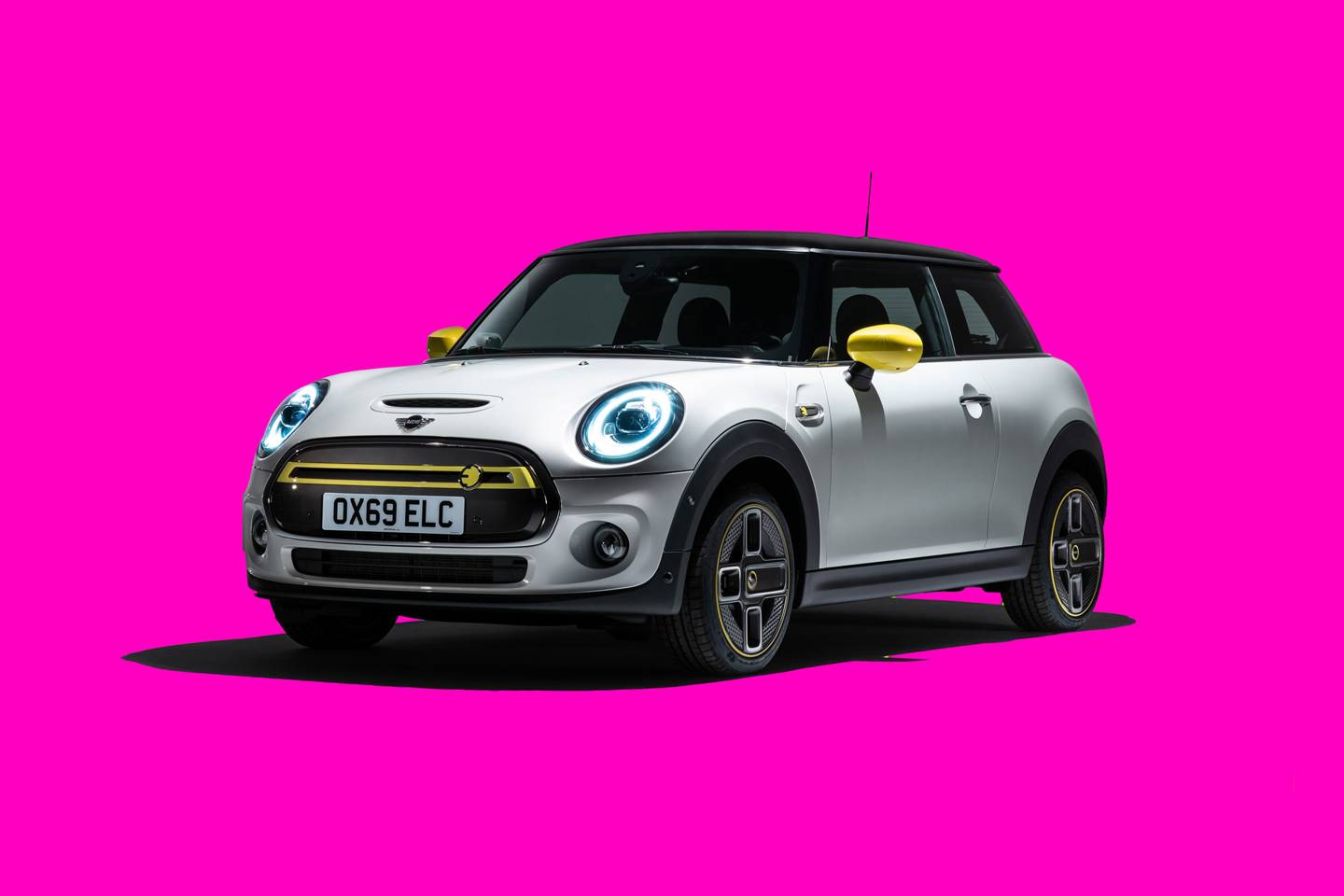Read The Full Article On: Wired
This is going to be a good year for those interested in electric cars, with so many high-profile launches from all the major manufacturers, that we are all – finally – going to be spoilt for choice when it comes to choosing your next, or indeed first, EV.
With this is mind, it makes sense that BMW wanted to get its new flagship electric car out as soon as possible in 2020. It’s also an important release for the German manufacturer as the Mini Electric will replace the BMW i3 as the group’s flagship all-electric car. What’s more, it will also be the cheapest EV in BMW’s lineup – starting at £24,400, it costs considerably less than that i3. And lastly, everyone seems interested in an electric version of an iconic car such as the Mini. We’ve been asked more about the Mini Electric than any other EV we’ve tested.
After our first-drive impressions, we had the chance to get more time behind the wheel of the Mini Electric to give you a full review. And it’s almost all good news.
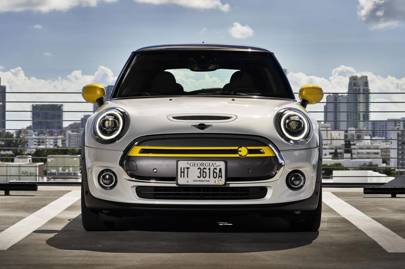
The original Mini was born out of the petrol rationing from the 1956 Suez Crisis, opening up the UK market for fuel-efficient vehicles. So it’s fitting the Mini should be reborn in response to the demand for electric cars.
And there’s been no messing with the Mini magic here, no tinkering with the lines to make it look futuristic. Only subtle changes give away the EV from the internal combustion engine (ICE) car such as the filled-in front grille and yellow badge work. Apart from this it’s all very familiar and welcoming – and there’s a good reason for that: the Mini Electric is built on the existing Mini architecture.
This is both good and bad. It means that BMW knew exactly what it was working with switching out the old ICE version for the electric motor in the front. The downside is that while the i3 enjoyed fancy weight-saving materials and an architecture design just for itself, the Mini gets no such benefits and special treatment.
Now it’s in the front, though (the i3’s was in the rear), the Mini’s electric motor is housed in a metal roll cage to protect it from frontal impacts. There are also additional steel braces where ICE Mini’s have aluminium again to reinforce the motor bay and stop crashes from causing too much damage.
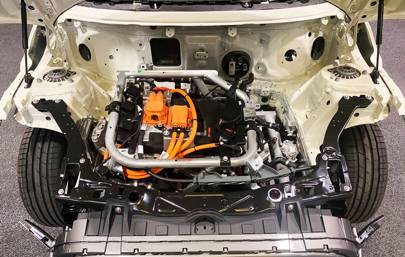
Sensibly, since the engineers were constrained by the existing body design, the wiring and batteries have been housed where the drive shaft and exhaust pipes would have been, with more batteries in the space that would have housed the fuel tank under the rear seats. Just 14 bolts are required to put the t-shaped battery in the car – and this is done in 35 seconds.
In order to fit the large battery pack in, BMW had to push the car up a little, but thanks to their combined heavy weight (there are 96 battery cells arranged in a 32.6kWh 12-module lithium-ion pack), the centre of gravity is lower, which is why it drives so well – more on which later.
In our 53-mile test session where we alternated between spirited and normal driving, we used up precisely 50 per cent of the car’s power. The Mini Electric can handle a range of between 124 and 144 miles, according to the Worldwide Harmonised Light Vehicle Test Procedure, and our figures seem to confirm this. Getting 145 miles out of the car on a single charge would be no issue if driven with a modicum of care.
That said, when considering the Mini you cannot ignore the greater ranges of other similar-sized cars, including the Kia Soul EV with a 400-mile urban range and 280 miles mixed range. This is such a key area that you cannot help but wish BMW had somehow squeezed just a little more out of the batteries in this car, or found room for more batteries.
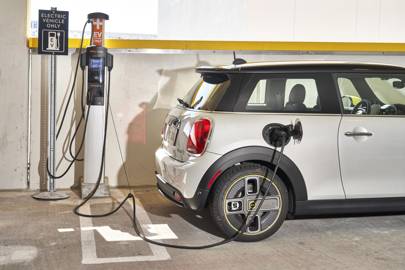
As for charging, the Mini Electric comes with both home and public charging cables for AC and DC charging. If you can find a 50kW DC fast-charging station, the Mini can get an 80 per cent charge from flat in just 36 minutes. For 11kW AC charging this rises to 150 minutes. If you are charging up at home with a three-pin plug – as the vast majority of us will do – you’re looking at 12 hours to get a full battery. The battery pack itself has a warranty of eight years or 100,000 miles.
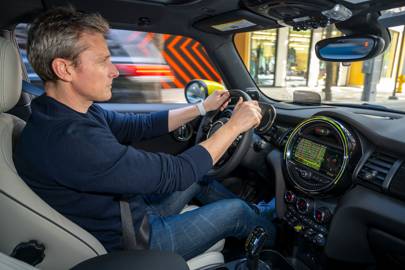
There’s no denying that the Mini Electric is immensely fun to drive. The car can go from zero to 62mph in 7.3 seconds with a maximum output of 184hp and torque of 270Nm – these are figures comparable to the Cooper S if you ignore the fact that top speed here is limited to 93mph.
The Mini feels planted while also channeling go-kart-like abilities to whip round tight corners or accelerate away from side roads. Also, the throttle mechanics on the Mini Electric are particularly good. It’s responsive but nuanced, which mean no guesswork is required when pressing down on the accelerator to get just the delivery of power you want.
You get four driving modes (Sport, Mid, Green and Green+). We felt Mid was the best combination. And while you can lighten the regenerative braking with a flick of a switch, in just a few miles you quickly become used to driving with one pedal, forgoing the brake entirely. To give you some idea of how strong the stopping power of the regenerative braking is, we managed to go from 70mph to standstill in 15 seconds just on high regeneration and not touching the brakes.
Perhaps the highest compliment we can pay the Mini Electric is that after driving it for 20 miles or so we completely forgot we were driving an EV down a mixture of country lanes and city streets. As a result, the Mini’s heart is still definitely in urban driving as opposed to long distance.
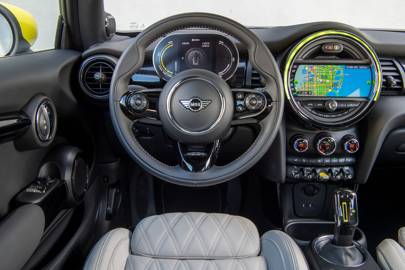
Inside the Mini Electric you are greeted with a smart array of switches, screens and gear. In this era, electric cars are often loaded with enticing specs but this won’t always be the case, so enjoy it while it lasts.
The 5.5-inch colour digital dash displays various factoids, including current flow of energy and range, while navigation is displayed on a responsive central 6.5-inch touchscreen. Traffic updates link to the navigation automatically, updating the car’s range – and this is why the sat-nav, usually an optional extra on Minis, is standard on the Electric. Cleverly, if the car thinks you’re not going to make it to the end of your journey, it will re-route you to public charging stations within range to top up.
You can spec a (loud) Harmon Kardon sound system, heads-up display, matrix LEDs, wireless phone charging in the central arm rest and a noticeably larger 8.8in version of that infotainment touchscreen, which we would suggest is worth the extra cash.
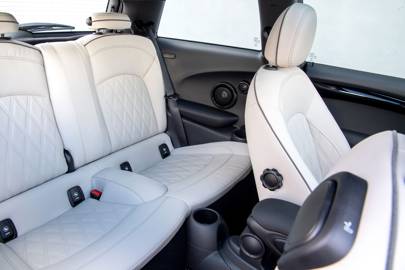
The only downside is space in the rear. Room for four adults? Yes. But only just – and you would not want to be in the back for long. We can’t help but wonder what could have have been done had Mini created a special chassis for the Electric in this regard. However, if BMW had taken this route there is no way you would be able to pick up an Electric for £600 less than the equivalent Cooper S model.
Some corners may have been cut in creating the Mini Electric, but it is hard to tell where once you get behind the wheel. The sense of fun is palpable and the handling is excitingly responsive. And, despite the use of the old Mini architecture, this is a fine replacement for BMW’s i3.
There are issues, yes. The range has already been bettered by some competitors, and the charging infrastructure is not there yet to rely on the super-fast charging stations. The space in the rear of the car is tight and compromises have been made shoehorning a new car into an old body.
But after leaving the car for a few weeks all you remember is the joy it instills. You stop thinking about if it’s electric or fossil-fuel powered. That is until you have to refill it, of course. Based on £0.163 per kWh on average, it costs just £5.31 to top the Mini Electric up to full charge. This means one mile costs you four pence. So it almost costs nothing to drive. And the fun comes at no extra charge either.

